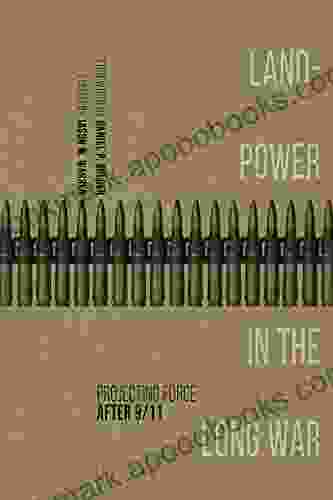Projecting Force After 11 Ausa Books

In Projecting Force After 11 Ausa Books, author and military expert John A. Nagl offers a comprehensive overview of the latest developments in military technology and strategy, and provides a unique perspective on the challenges and opportunities facing the U.S. military in the 21st century.
4.6 out of 5
| Language | : | English |
| File size | : | 1124 KB |
| Text-to-Speech | : | Enabled |
| Screen Reader | : | Supported |
| Enhanced typesetting | : | Enabled |
| Word Wise | : | Enabled |
| Print length | : | 365 pages |
| X-Ray for textbooks | : | Enabled |
Drawing on his extensive experience in the field, Nagl argues that the U.S. military must adapt to a new era of warfare characterized by increased complexity, uncertainty, and interconnectedness. He calls for a new approach to force projection that is more flexible, agile, and sustainable, and that emphasizes the importance of building partnerships and alliances.
Projecting Force After 11 Ausa Books is a must-read for anyone interested in the future of warfare. Nagl's insights are invaluable for policymakers, military leaders, and anyone else who wants to understand the challenges and opportunities facing the U.S. military in the 21st century.
Table of Contents
- The Changing Character of Warfare
- The Challenges Facing the U.S. Military
- A New Approach to Force Projection
The United States has been the world's preeminent military power for over a century. However, the world is changing, and the U.S. military must adapt to a new era of warfare characterized by increased complexity, uncertainty, and interconnectedness.
In Projecting Force After 11 Ausa Books, author and military expert John A. Nagl argues that the U.S. military must adopt a new approach to force projection that is more flexible, agile, and sustainable. He calls for a shift from large-scale, expeditionary operations to a more distributed and dispersed approach that emphasizes the importance of building partnerships and alliances.
The Changing Character of Warfare
The character of warfare has changed dramatically in recent years. The rise of new technologies, such as drones and cyber weapons, has made it possible to conduct warfare from a distance, with less risk to human life. At the same time, the spread of globalization has made the world more interconnected, creating new opportunities for conflict and instability.
These changes have made it more difficult for the U.S. military to project force effectively. Traditional methods of force projection, such as large-scale amphibious landings and air strikes, are no longer as effective as they once were. The U.S. military must find new ways to project force that are more flexible, agile, and sustainable.
The Challenges Facing the U.S. Military
The U.S. military faces a number of challenges in the 21st century. These challenges include:
- The rise of new technologies: The rapid development of new technologies, such as drones and cyber weapons, is changing the character of warfare and making it more difficult for the U.S. military to project force effectively.
- The spread of globalization: The spread of globalization has made the world more interconnected, creating new opportunities for conflict and instability. The U.S. military must be prepared to respond to a wider range of threats in a more dispersed and distributed manner.
- The changing nature of conflict: The nature of conflict is changing, with a growing emphasis on hybrid warfare and irregular warfare. The U.S. military must be able to adapt to a wider range of threats and challenges.
- Budget constraints: The U.S. military is facing increasing budget constraints, which are making it more difficult to maintain a large and well-equipped force.
A New Approach to Force Projection
The U.S. military must adopt a new approach to force projection that is more flexible, agile, and sustainable. This new approach must be based on the following principles:
- Flexibility: The U.S. military must be able to respond to a wide range of threats and challenges, in a variety of different environments. This requires a more flexible and agile force that can be deployed quickly and easily.
- Agility: The U.S. military must be able to move quickly and adapt to changing circumstances. This requires a more agile force that can operate in a distributed and dispersed manner.
- Sustainability: The U.S. military must be able to sustain its operations over a long period of time. This requires a more sustainable force that can operate with less logistical support.
The U.S. military is already taking steps to implement this new approach to force projection. The Army has created new units, such as the Stryker Brigade Combat Teams, that are more flexible and agile than traditional units. The Navy is developing new ships, such as the littoral combat ship, that are more versatile and can operate in a wider range of environments. The Air Force is developing new aircraft, such as the F-35 Joint Strike Fighter, that are more stealthy and can carry a wider range of weapons.
The U.S. military is facing a number of challenges in the 21st century. However, the military is also taking steps to adapt to these challenges and develop a new approach to force projection that is more flexible, agile, and sustainable. This new approach will help the U.S. military maintain its preeminence in the world for years to come.
4.6 out of 5
| Language | : | English |
| File size | : | 1124 KB |
| Text-to-Speech | : | Enabled |
| Screen Reader | : | Supported |
| Enhanced typesetting | : | Enabled |
| Word Wise | : | Enabled |
| Print length | : | 365 pages |
| X-Ray for textbooks | : | Enabled |
Do you want to contribute by writing guest posts on this blog?
Please contact us and send us a resume of previous articles that you have written.
 Book
Book Novel
Novel Page
Page Chapter
Chapter Text
Text Story
Story Genre
Genre Reader
Reader Library
Library Paperback
Paperback E-book
E-book Magazine
Magazine Newspaper
Newspaper Paragraph
Paragraph Sentence
Sentence Bookmark
Bookmark Shelf
Shelf Glossary
Glossary Bibliography
Bibliography Foreword
Foreword Preface
Preface Synopsis
Synopsis Annotation
Annotation Footnote
Footnote Manuscript
Manuscript Scroll
Scroll Codex
Codex Tome
Tome Bestseller
Bestseller Classics
Classics Library card
Library card Narrative
Narrative Biography
Biography Autobiography
Autobiography Memoir
Memoir Reference
Reference Encyclopedia
Encyclopedia Rebecca A Duda
Rebecca A Duda Sarah M Stitzlein
Sarah M Stitzlein Elaina Jadin
Elaina Jadin Elizabeth Beaumont
Elizabeth Beaumont Jamil Effarah
Jamil Effarah Paul Kurtz
Paul Kurtz Lili Plume
Lili Plume John Russell Fearn
John Russell Fearn Marcus Zulian Teixeira
Marcus Zulian Teixeira Lynn Kleiner
Lynn Kleiner International Bolshevik Tendency
International Bolshevik Tendency Dr Howard Rankin
Dr Howard Rankin Edward Willett
Edward Willett Neetha Naidu
Neetha Naidu Elaine Cunningham
Elaine Cunningham Eddie Cleveland
Eddie Cleveland Jon Land
Jon Land Luke Levi
Luke Levi Michael Newton
Michael Newton Pat Mcgeehan
Pat Mcgeehan
Light bulbAdvertise smarter! Our strategic ad space ensures maximum exposure. Reserve your spot today!

 Colin RichardsonUnleash the Fury: Explore the Masterful Metallica Death Magnetic Songbook
Colin RichardsonUnleash the Fury: Explore the Masterful Metallica Death Magnetic Songbook
 Ralph TurnerUnravel the Enigmatic "Vein of Deceit" and Embark on a Literary Journey of...
Ralph TurnerUnravel the Enigmatic "Vein of Deceit" and Embark on a Literary Journey of... Brian WestFollow ·16.4k
Brian WestFollow ·16.4k Tony CarterFollow ·4.9k
Tony CarterFollow ·4.9k Joe SimmonsFollow ·2.8k
Joe SimmonsFollow ·2.8k Edwin BlairFollow ·18.6k
Edwin BlairFollow ·18.6k Joshua ReedFollow ·6.5k
Joshua ReedFollow ·6.5k Gene PowellFollow ·10.3k
Gene PowellFollow ·10.3k Carl WalkerFollow ·14.5k
Carl WalkerFollow ·14.5k Herman MitchellFollow ·12.9k
Herman MitchellFollow ·12.9k

 Eugene Powell
Eugene PowellFat Cat Stories: Level At Word Family - A Purrfect Start...
Introducing the 'At'...

 William Powell
William PowellUnveiling the Treasures of Russian Poetry: The Cambridge...
Immerse yourself in the...

 Roberto Bolaño
Roberto BolañoUnveiling the Treasures of Beowulf: A Guided Tour with...
: Delving into the...

 Foster Hayes
Foster HayesTransport, Climate Change and the City: Tackling Urban...
Transport is a major...

 Calvin Fisher
Calvin FisherHow To Make It In The Music Industry: The Ultimate Guide...
Are you an aspiring musician with...

 Rick Nelson
Rick NelsonUnveiling the Enigmatic World of Gary Chester's "The New...
Step into a World...
4.6 out of 5
| Language | : | English |
| File size | : | 1124 KB |
| Text-to-Speech | : | Enabled |
| Screen Reader | : | Supported |
| Enhanced typesetting | : | Enabled |
| Word Wise | : | Enabled |
| Print length | : | 365 pages |
| X-Ray for textbooks | : | Enabled |








